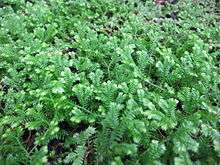Selaginella kraussiana
Selaginella kraussiana, Krauss' spikemoss,[2] Krauss's clubmoss,[3] or African clubmoss, is a species of vascular plant found naturally in the Azores and parts of mainland Africa.[4] It belongs to the very ancient lineage of plants known as the clubmosses.
| Selaginella kraussiana | |
|---|---|
 | |
| Scientific classification | |
| Kingdom: | Plantae |
| Clade: | Tracheophytes |
| Clade: | Lycophytes |
| Class: | Lycopodiopsida |
| Order: | Selaginellales |
| Family: | Selaginellaceae |
| Genus: | Selaginella |
| Species: | S. kraussiana |
| Binomial name | |
| Selaginella kraussiana | |
Description
Growing to just 5 cm (2.0 in) high, it is a low-growing, mat-forming evergreen perennial with primitive fern-like leaves, that spreads via rooting stems.
 Illustrating greener coloration when grown in brighter light
Illustrating greener coloration when grown in brighter light Close-up of the foliage
Close-up of the foliage
Distribution
Its native distribution is the Azores, the Canary Islands, and parts of south and east Africa.[4] Since its introduction to Britain in 1878 it has spread slowly, and was first recorded in the wild in 1917 in west Cornwall (UK) and County Leitrim (Ireland), often as a greenhouse weed.[5]
Selaginella kraussiana is listed on the New Zealand National Pest Plant Accord since it is an invasive species. It is common in many parts of New Zealand and Australia where it forms dense mats in shaded areas.[6][7]
Cultivation
Selaginella kraussiana is cultivated for ornamental purposes.[8] It requires a minimum temperature of 5 °C (41 °F), and in temperate regions is grown under glass as a houseplant. The species[9] and the cultivar ‘Brownii’[10] have both gained the Royal Horticultural Society's Award of Garden Merit.[11] Other cultivars include ‘Aurea’ and ‘Gold Tips’. They prefer a sheltered spot in full or partial shade, in moist, well-drained acid or neutral soil.
In the Winter a cultivar often described as Selaginella kraussiana 'Frosty Fern' is sold as a house plant due to its white tipped foliage, however this is more normally the taller growing Selaginella martensii rather than the shorter, creeping krasussiana.
References
- "Selaginella kraussiana". Flora of Northern Ireland. Ulster Museum. Retrieved 2009-03-08.
- "Selaginella kraussiana". Natural Resources Conservation Service PLANTS Database. USDA. Retrieved 9 November 2015.
- "BSBI List 2007". Botanical Society of Britain and Ireland. Archived from the original (xls) on 2015-01-25. Retrieved 2014-10-17.
- "GBIF Selaginella kraussiana (Kunze) A. Braun". Copenhagen, Denmark: Global Biodiversity Information System.
- "Online Atlas of the British and Irish Flora, Selaginella kraussiana (Kraus`s Clubmoss)". Biological Records Centre and Botanical Society of Britain and Ireland.
- Flora of New Zealand
- Brownsey, Patrick John; Perrie, Leon Richard (2018). Selaginellaceae (PDF). Lincoln, New Zealand: Manaaki Whenua-Landcare Research New Zealand Ltd. pp. 3–5. doi:10.7931/B18S6Q. ISBN 978-0-947525-41-5. OCLC 1082892769.
- "Selaginella kraussiana". Germplasm Resources Information Network (GRIN). Agricultural Research Service (ARS), United States Department of Agriculture (USDA). Retrieved 19 January 2018.
- "Selaginella kraussiana". Royal Horticultural Society. Retrieved 23 July 2013.
- "RHS Plantfinder - Selaginella kraussiana 'Brownii'". Retrieved 7 November 2018.
- "AGM Plants - Ornamental" (PDF). Royal Horticultural Society. July 2017. p. 96. Retrieved 8 November 2018.
External links

